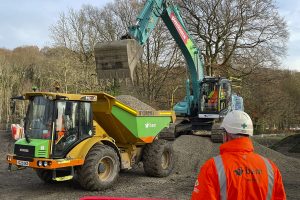Digital twins are reshaping the global construction industry by enabling better decision-making, reducing risks and increasing efficiency throughout a project’s lifecycle. Unlike traditional methods that rely on static data, digital twins provide a dynamic, real-time representation of physical assets, enhancing project planning, execution and facility management.
The rise of digital twins in construction
The concept of digital twins has gained traction due to the increasing adoption of Building Information Modelling (BIM), IoT sensors and cloud computing. A report by McKinsey & Company highlights that digital twins can improve project delivery efficiency by up to 50 per cent, reducing costs and enhancing sustainability (McKinsey, 2023). By incorporating real-time data and predictive analytics, digital twins help construction professionals move from reactive to proactive decision-making.
Redefining construction workflows
Construction projects are becoming increasingly complex, requiring precise coordination between teams and resources. Digital twins address these challenges by:
- Providing an accurate project baseline: Capturing existing site conditions through high-fidelity reality capture ensures alignment between design and execution.
- Enabling real-time collaboration: Teams across different locations can access and interact with up-to-date project data, reducing miscommunication and delays.
- Mitigating risks proactively: AI-powered analysis can identify potential clashes, safety hazards and cost overruns before they impact the project timeline.
- Improving safety measures: Digital twins can simulate construction environments to enhance worker safety by predicting hazardous conditions and ensuring compliance with safety regulations (Autodesk, 2024).
Enhancing long-term asset management
Beyond project completion, digital twins support ongoing facility operations, improving efficiency and extending asset lifespan. Key benefits include:
- Predictive maintenance: AI-driven insights allow facility managers to anticipate maintenance needs before failures occur, reducing downtime and operational costs.
- Energy performance monitoring: Digital twins provide real-time data on energy usage, allowing for smarter decision-making to improve efficiency and sustainability.
- Seamless retrofitting and renovations: Accurate digital records simplify future upgrades, reducing disruption and ensuring data continuity.
- Extending building lifespan: Research from the World Economic Forum suggests that digital twins can extend a building’s lifecycle by up to 20 per cent through optimised maintenance planning (WEF, 2023).
A new era of sustainability and compliance
As regulatory demands and environmental concerns grow, digital twins play a vital role in:
- Optimising material usage: Reducing construction waste by simulating design changes before physical implementation.
- Tracking carbon footprint: Monitoring emissions and identifying opportunities to improve sustainability practices.
- Ensuring compliance: Automating documentation processes to meet evolving industry standards and government regulations.
- Enhancing LEED and BREEAM certification processes: Digital twins streamline the reporting and verification of sustainable building practices, facilitating compliance with green building standards (USGBC, 2024).
Future-proofing the construction industry
As technology advances, digital twins will continue to evolve, incorporating:
- AI-driven automation: Streamlining repetitive tasks and providing predictive analytics for better decision-making.
- Integration with IoT and smart buildings: Enabling real-time monitoring and adaptive management of assets.
- Scalable cloud-based solutions: Providing accessible, centralised data for stakeholders across global projects.
- Digital twins for urban planning: Cities are increasingly using digital twins to model infrastructure, optimise traffic flow and enhance emergency response strategies (Smart Cities World, 2024).
Digital twins are not just about creating 3D models – they represent a shift towards a smarter, data-driven construction ecosystem. As more firms adopt this approach, the industry will experience increased efficiency, lower costs and enhanced resilience.
 To explore more about how digital twins can benefit your next project, download our ebook here.
To explore more about how digital twins can benefit your next project, download our ebook here.
 Construction News Read UK Construction Industry News, Analysis, Opinion and data
Construction News Read UK Construction Industry News, Analysis, Opinion and data 





